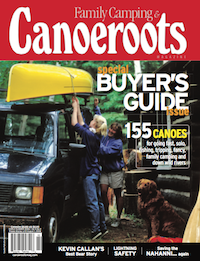Essential Trip Tackle Box
You don’t need a lot of gear to catch a lot of fish. All the lures necessary to target a wide range of species will fit easily into a 7- by 11-inch plastic case.
Fill it with mid-sized spinners, gold and silver spoons, three-to six-inch diving minnow-shaped crank baits, coloured head jigs and soft plastic grubs. In separate film containers bring split shot sinkers, single hooks, some snap swivels to reduce line twist and a few fine wire leaders if targeting pike.
Round out your kit with a spare 100-metre spool of 8- to 12-pound test line, a fillet knife and needle-nose pliers. If you’re feeling confident, throw in a scale and tape measure. Stuff it all in a small tackle bag or slide it into an easy-to-reach pocket of a canoe pack.
Keep Your Rod Ready
Lash a two-foot length of three-inch PVC pipe under the seat to function as a quick-draw rod and reel holster. Slide the rod through from the middle of the canoe toward the end so the tip is tucked under the bow or stern deck. Secure the reel with a loop of shock cord. This simple system allows for spur-of-the-moment angling and reduces the chances you’ll end up with a broken rod at the end of a portage.
Fish On the Go
Test the waters while still making headway toward your next campsite by trolling as you go.
Spoons or minnow-shaped crank baits are the best lures for trolling. Let them run beside the canoe so you can gauge the correct speed for seductive lure behavior.
Cast behind the canoe, let out about 50 metres of line and brace the rod against the gunwale so you can keep an eye on it while paddling.
The best trolling speed for most lures is slower than you’d normally paddle, so be patient and remind your trip mates that if they are intent on paddling fast they can go ahead to the campsite and collect enough firewood for a fish fry.
Find the Fish
Fish gravitate to prominent features found along the bottom or shore. Cast your lure along the edges of weed beds or over shoals and drop-offs. Cover a wide range of depths while trolling by weaving in close to shore until you can see bottom before veering off again.
In the cold water of early spring all species will be in water less than 15 feet deep. As the waters warm fish move deeper, especially cold-water species like lake, brook and rainbow trout. Warm-water species like bass, walleye, pike and perch may still be found as shallow as five or 10 feet through the summer,
so long as there’s cover like weeds, submerged wood or overhanging trees.
In rivers, fish congregate in areas of transition. Look for the places where strong currents converge with deep water, like at the base of rapids or the deep holes and undercut banks of corner pools. Cast across the river and draw your lure through the current.
It’s a Keeper!
With luck you’ll end the day by preparing a meal of freshly caught fish.
Lay out a two-ply piece of tin foil and spread a layer of butter or margarine over it. Place the fillets on the butter and top each with a slice of lemon, a slice of onion, a spoonful of diced tomatoes, salt and pepper.
Cover with another sheet of foil and fold the sheets together to seal all edges. Place on a grill over a medium-hot fire. When the foil puffs up pierce a few holes in the top and let it steam for 10 minutes. Spoon any excess juice over rice and enjoy the rewards of your angling efforts knowing there are no pots to wash.
James Smedley is a contributing editor to Ontario Out of Doors magazine.




